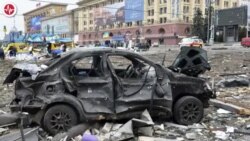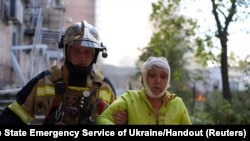On October 10, Russia launched dozens of missiles at Ukrainian cities in retaliation for the bombing of the Kerch Strait Bridge, which links the Russian-occupied Crimean Peninsula with the Russian mainland.
Russia, which has systematically targeted civilian infrastructure since launching its invasion of Ukraine on February 24, claimed the latest wave of attacks “was in response to Kyiv’s terrorism.”
Russian President Vladimir Putin claimed the strikes were solely aimed at legitimate military and infrastructure targets.
"This morning, on the initiative of the Ministry of Defense and according to a plan [formulated by] the Russian General Staff, massed strikes were carried out using high-precision, long-range air, sea and land-based weapons against energy, military command and communications facilities of Ukraine," Putin said.
But that is false. Russia did target military and energy facilities. But abundant evidence shows strikes at civilian infrastructure and cultural sites.
In the Ukrainian capital, Kyiv, witness accounts, photos and videos prove that museums, an office building, a pedestrian bridge, a park, a busy intersection and other civilian areas were hammered in the barrage.
According to Ukraine’s air force, the October 10 attack was “the largest missile attack since the beginning of the hot phase of the war.”
Ukraine said more than 80 rockets, including “[h]igh-precision land-based, sea-based, and air-based cruise missiles,” and a dozen Iranian-made Shahed-136 kamikaze drones were used in the assault.
Though far from the front lines, Kyiv was heavily targeted.
Kyiv Mayor Vitaliy Klitschko cited damage to 45 residential buildings, including three schools, one kindergarten and two after-school education buildings, six cultural institutions, five health care facilities, and five “objects of critical infrastructure, housing and communal services” had been damaged.
Ukraine officials said at least 19 people were killed and more than 100 were wounded. Besides Kyiv, Russian strikes hit the cities of Lviv in western Ukraine, Kharkiv in the north, Dnipro and Zaporizhzhia in central Ukraine, and the Black Sea port of Odesa.
Shevchenko Park in central Kyiv was among the targets, with the crater of a missile blast seen next to a children’s playground. Also damaged were the nearby Khanenko Museum — the key world art museum in Ukraine — and the Taras Shevchenko National University of Kyiv.
Near the university campus, park and other cultural sites, a Russian rocket slammed into the busy intersection of Volodymyrska Street and Shevchenko Boulevard at 8 a.m., incinerating cars and causing more than a dozen casualties.
Russia hit a pedestrian bridge in Khreshchatyk Park and damaged the National Philharmonic of Ukraine. The 101 Tower, housing an office and research center for the Korean electronics firm Samsung, also was struck.
Social media users noted that the visa office of the German consulate was located on the 22nd floor of the 101 Tower, but Taras Mishchenko, editor-in-chief of Ukraine’s Mezha.Media, said the consulate had not been operating.
The Wall Street Journal’s Matthew Luxmoore reported that Russia’s attacks on Lviv “left half the city without water, electricity or internet.”
Kyiv has not officially claimed responsibility for the Crimea bridge attack, The Associated Press reported, but Ukraine’s ambassador to Britain, Vadym Prystaiko, on Monday called the bridge a legitimate military target.
Ukrainian Foreign Minister Dmytro Kubelo pushed back at Russian claims that Putin had been provoked to launch the latest barrage of strikes.
“Russia had been constantly hitting Ukraine with missiles before the bridge, too. Putin is desperate because of battlefield defeats and uses missile terror to try to change the pace of war in his favor,” he wrote.
In July, Ukrainian President Volodymyr Zelenskyy described Russia’s systematic targeting of civilian areas as “missile terror.”
At that time, Zelenskyy said Russia had launched 2,960 missiles at Ukrainian cities, adding “the main targets of missiles are civilian objects.”
Russia has been widely accused of indiscriminate bombing, or deliberately hitting civilian targets. Most infamous was a March 16 Russian airstrike on the Donetsk Academic Regional Drama Theater in Mariupol, where civilians sheltered amid a Russian offensive. Up to 600 people are believed to have died.
As previously reported by Polygraph.info, from its wars in Chechnya to the Syrian civil war, indiscriminate bombing of civilian targets has arguably been a signature Russian tactic.
Amid the latest assault, the United Nations General Assembly met to discuss a potential response to Russia’s annexation of four Ukrainian regions last month.
U.N. Secretary-General Antonio Guterres said he was “deeply shocked” by the large-scale missile strikes on cities and civilian areas across Ukraine.
“This constitutes another unacceptable escalation of the war, and as always, civilians are paying the highest price,” he said.
The strikes continued October 11, the AP reported:
“The bombardment Tuesday struck both energy infrastructure and civilian areas, just as Monday’s attacks did. One person was killed when 12 missiles slammed into public facilities in the southern city of Zaporizhzhia, setting off a large fire, the State Emergency Service said.
“A local official said the missiles hit a school, residential buildings and medical facilities.”









